|
Centrip Editorial Board
Stroll Along the Nakasendo Highway and Visit Post Towns: Nakatsugawa-juku, Ochiai-juku, and Magome-juku

Table of Contents
- Attractions in Nakatsugawa
- How to Get to Nakatsugawa from Nagoya
- Nakatsugawa Station and Nakatsugawa-juku
- To the Ochiai-juku
- Ochiai's Stone-paved Streets and New Tea Houses
- To Magome-juku, an Inn on a Steep Slope
- Castle in the Sky the Ruins of Naegi Castle
- Chestnut-shaped sweet potatoes originating in Nakatsugawa
- Wrap-up
Attractions in Nakatsugawa
In the past two roads developed that connected Edo (Tokyo) and Kyoto, in the Edo Period. The Tokaido, which runs along the coast, and the Nakasendo, which runs inland through the mountains. Many travelers have traversed the Nakasendo road throughout history since there were no delays to river crossing from heavy rain travelers were more than happy to put up with the length, steep mountain roads, and bitterly cold winters.
Where there were once three post towns, Magome-juku, Ochiai-juku, and Nakatsugawa-juku, lies the city of Nakatsugawa, a historical shelter for travelers on the Nakasendo Road. The natural beauty surrounded by mountains and the atmosphere of the townscape along the highway with its sense of history still attracts many tourists from Japan and abroad.
Join us as we introduce some of the charms of Nakatsugawa with a focus on the post towns.
How to Get to Nakatsugawa from Nagoya
If you take the limited express Wide View Shinano from JR Nagoya Station, it takes about 50 minutes to get to Nakatsugawa Station for a total of ¥2,540, including the limited express fare. If you don't want to use the limited express, you can get there from JR Nagoya Station on the JR Chuo Main Line's rapid train, which takes about 1 hour and 20 minutes for ¥1,340.
Achi Village, a hot spring resort, famous for its beautiful starry sky, is about 40 minutes by bus from JR Nakatsugawa Station. Or if you'd like, it takes about 1 hour and 40 minutes by connecting bus, to Gero Onsen, one of the three famous hot springs in Japan.
By car, you can get to the Nakatsugawa Interchange in about an hour if you use the Central Expressway, and also easily access the city of Nakatsugawa, as well as other beautiful attractions in the area.
Nakatsugawa Station and Nakatsugawa-juku
Get off at Nakatsugawa Station, and proceed about 100 meters down the main street, in-front-of the shopping center, at the intersection called Shinmachi, you will see the entrance to the old Nakatsugawa Road. Turn right at the intersection, and you come upon Suya, a shop that sells Kuri-Kinton, a local specialty. Head even further and the streets of Nakatsugawa-juku come into view.
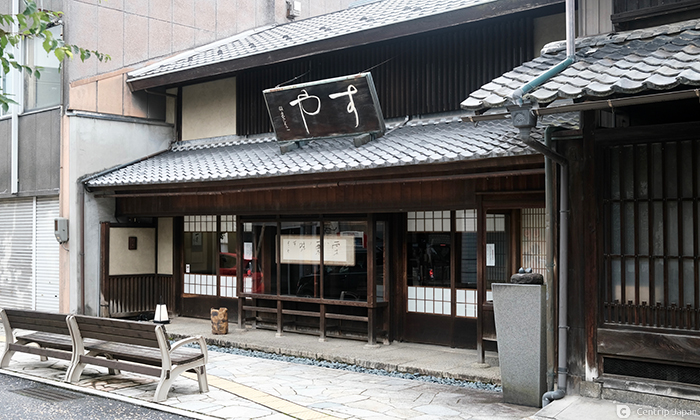 The famous Kuri-Kinton shop Suya
The famous Kuri-Kinton shop Suya
 Suya, written in Hiragana
Suya, written in Hiragana
Nakatsugawa-juku, the 45th post town on the Nakasendo Road, once prospered as the area's leading commercial district. Charming old buildings line the streets of this vibrant town. Many of the houses have Udatsu (fireproof decorations on the roofs of Japanese houses), which were a symbol of wealthy families.
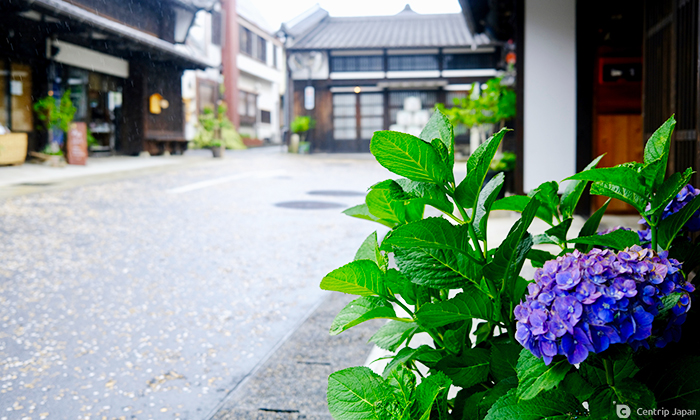 Townscape of Nakatsugawa-juku
Townscape of Nakatsugawa-juku
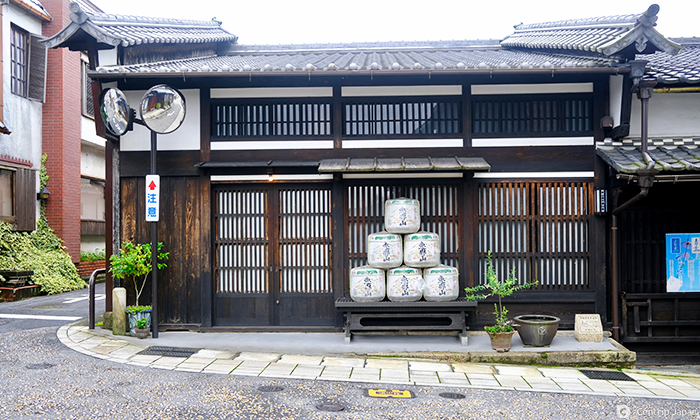 A sake brewery in Nakatsugawa, around since the Edo period
A sake brewery in Nakatsugawa, around since the Edo period
In the center of Nakatsugawa-juku, there is the Nakasendo Historical Museum, which exhibits valuable documents and archives, such as old documents preserved in an old house in Nakatsugawa-juku. In recent years, there are more and more places where you can stop by on your way to the museum, such as cafes and shops that make use of the exteriors of the historical houses.
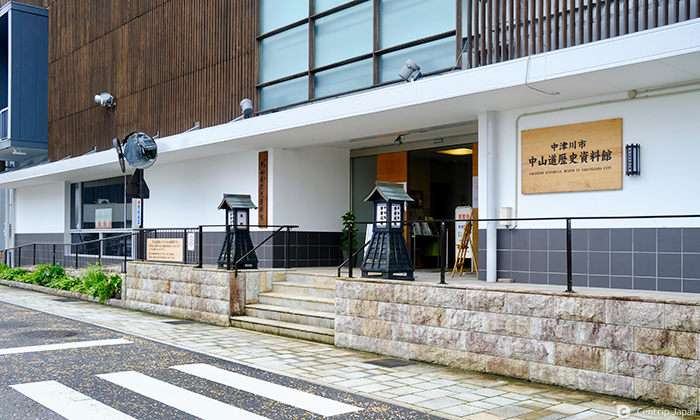 Nakasendo Historical Museum
Nakasendo Historical Museum
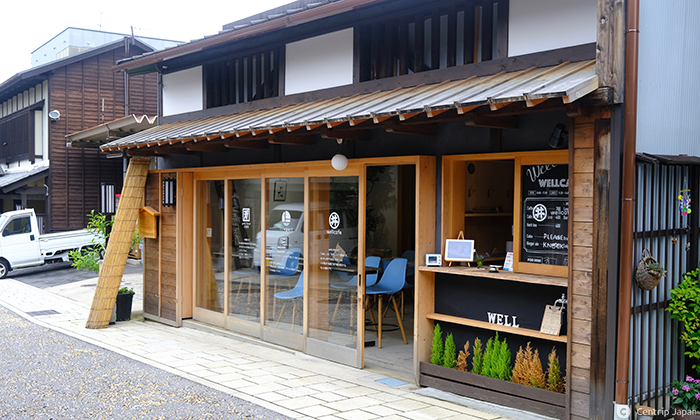 A café that blends in with the streets of Nakatsugawa's-juku
A café that blends in with the streets of Nakatsugawa's-juku
To the Ochiai-juku
Return to Nakatsugawa Station and take the bus bound for Magome, get off at Ochiai bus stop, and head for Ochiai-juku. It takes about 25 minutes. To get to Ochiai-juku from Nakatsugawa-juku, it takes about an hour, and if it's a nice day it makes for a great walk. From Ochiai-juku to Magome-juku, it takes about 15 minutes by the same bus, or about an hour on foot.
Ochiai-juku, located between Nakatsugawa-juku and Magome-juku. In the center of Ochiai-juku, is a stronghold where high ranking people stayed. Constructed in 1818, it remains unchanged since then.
 The main gate of the Ochiai-juku Main Camp
The main gate of the Ochiai-juku Main Camp
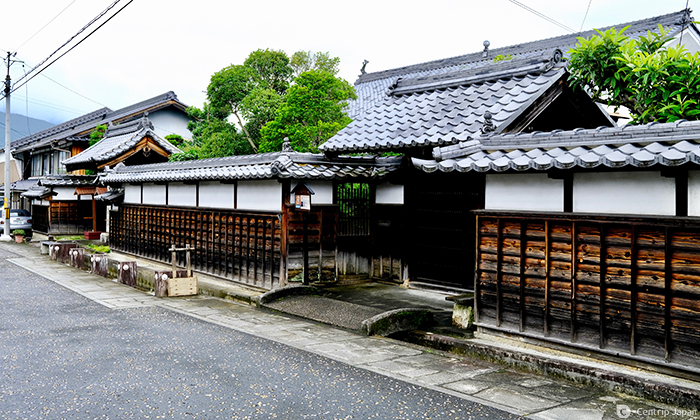 The outside wall of Ochiai-juku.
The outside wall of Ochiai-juku.
Today's Ochiai-juku is not a busy tourist destination, but a quiet place where you can imagine the bustle of the old post town.
Attractions include Zenshoji Temple, with its impressive pine trees by the gate, and Kofukuji Temple, known for its beautiful mossy gardens and famous for its cherry blossoms. These historic temples offer personal experiences such as zazen (meditation) and hand-written sutras for tourists.
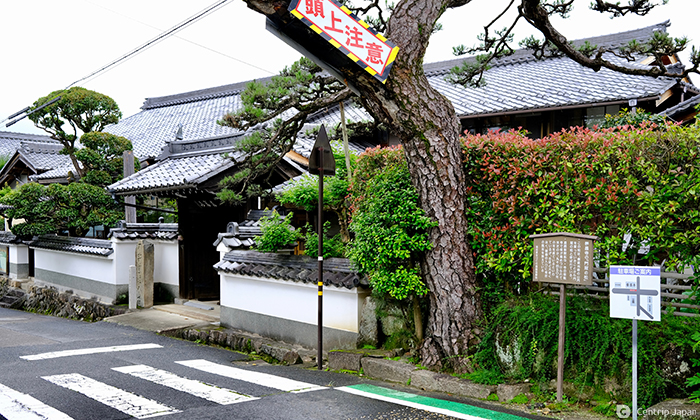 Zenshoji Temple in Ochiai-juku.
Zenshoji Temple in Ochiai-juku.
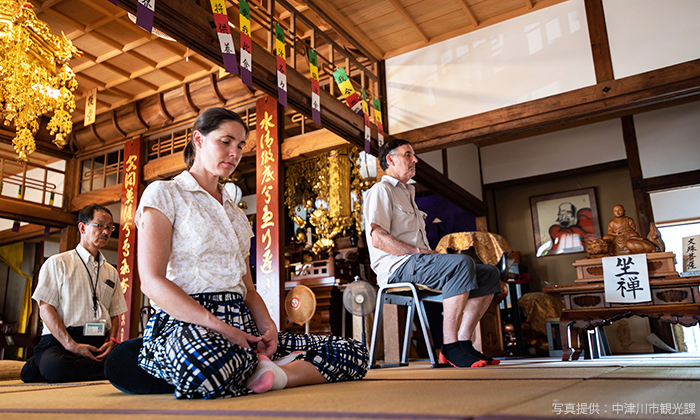 Zazen at Zenshoji Temple
Zazen at Zenshoji Temple
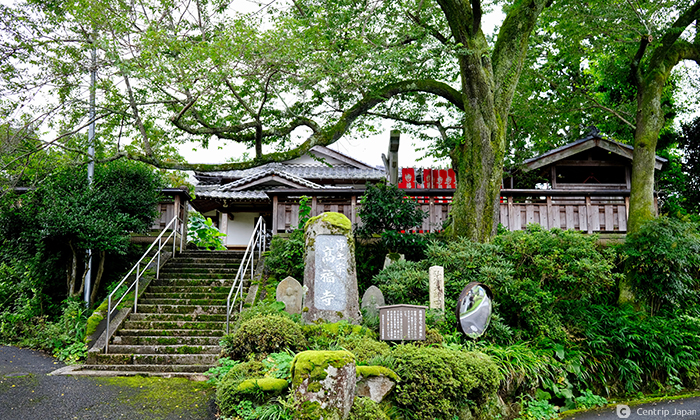 Ochiai's Kofukuji Temple.
Ochiai's Kofukuji Temple.
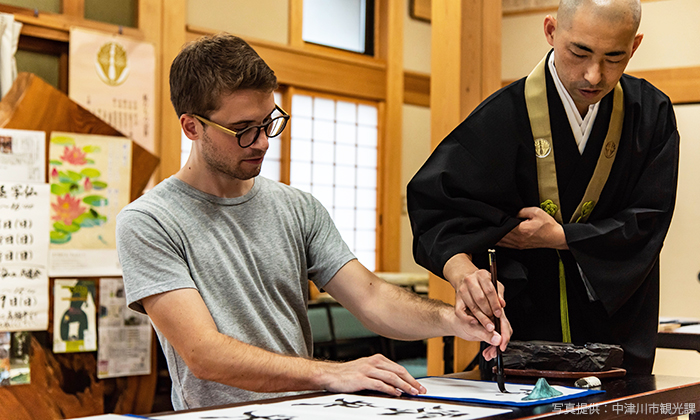 Calligraphy at Kofukuji Temple
Calligraphy at Kofukuji Temple
Ochiai's Stone-paved Streets and New Tea Houses
On the way from Ochiai-juku to Magome-juku, stop and take in the stone-paved streets of Ochiai's old Nakasendo Road. The magnificent stone-paved road, preserved in its original form, stretches for about 800 meters.

The cobblestones made it easier for travelers to walk up steep slopes and serve to protect the hill from heavy rain. The historic pathway surrounded by deep greenery makes for a very cleansing walk.
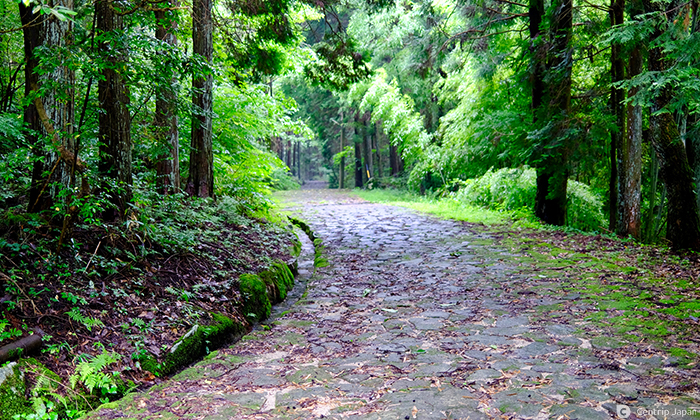 800 meters of cobblestones in Ochiai.
800 meters of cobblestones in Ochiai.
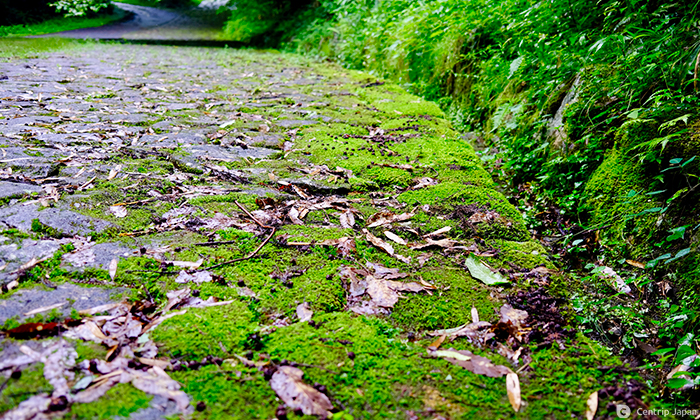 Vibrant green moss
Vibrant green moss
Near the stone-paved area of Ochiai is Shin Chaya, and a stone monument inscribed with the words "North from here is Kisoji". Written by Toson Shimazaki, a native of the area, and one of Japan's leading modern writers. Across from the monument stands a traditional Japanese guest house.
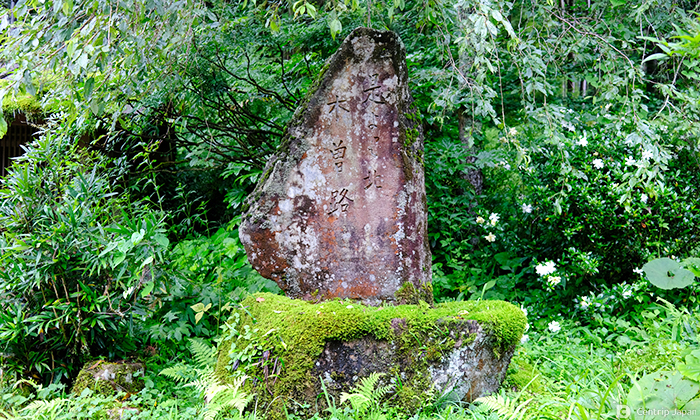 Stone monument by Toson Shimazaki: North from here is Kisoji
Stone monument by Toson Shimazaki: North from here is Kisoji
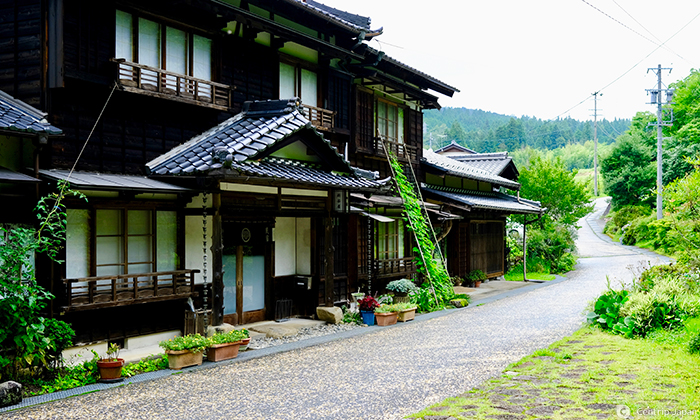 Shin Chaya Ryokan
Shin Chaya Ryokan
Moving on from Shin Chaya towards Magome-juku, rice paddies and terraced fields come into view on the slopes of the hills. During the rainy season from June to July, the bright green color of the rice ears is a sight to behold. If you are interested in the Japanese countryside, definitely check this place out.
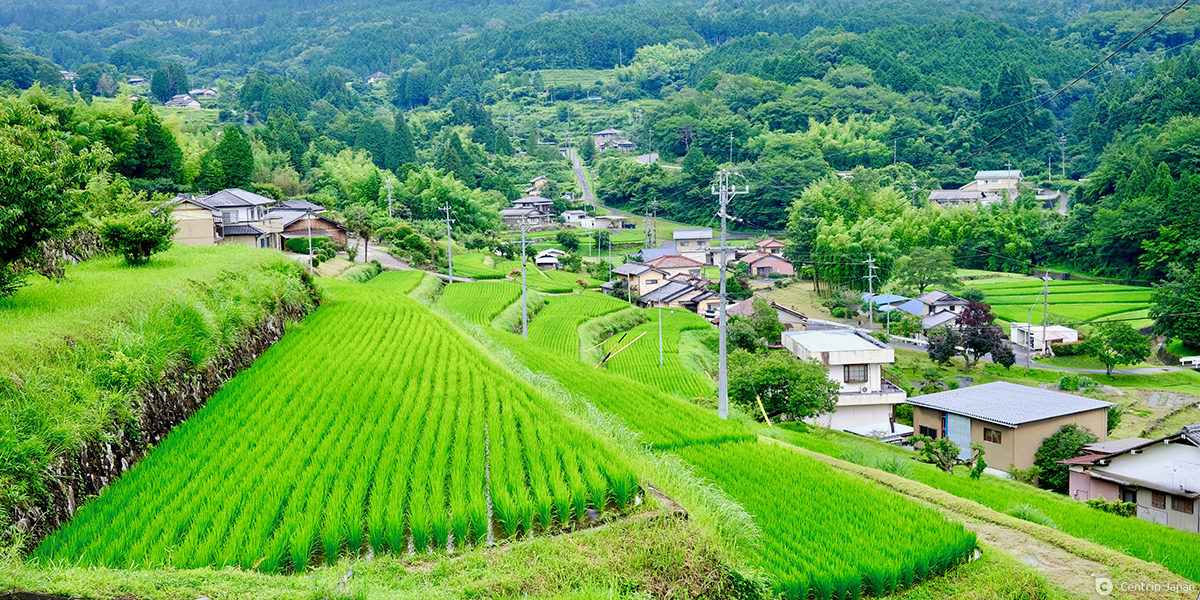
To Magome-juku, an Inn on a Steep Slope
Toson Shimazaki's house "Before the Dawn" is considered to be one of the masterpieces of modern Japanese literature. The novel, based on Toson's father, is set in a mountainous post town on the Nakasendo road and depicts the upheaval of the Edo and Meiji periods. The opening sentence of the novel, "The entire Kisoji is in the mountains." is a very famous phrase.
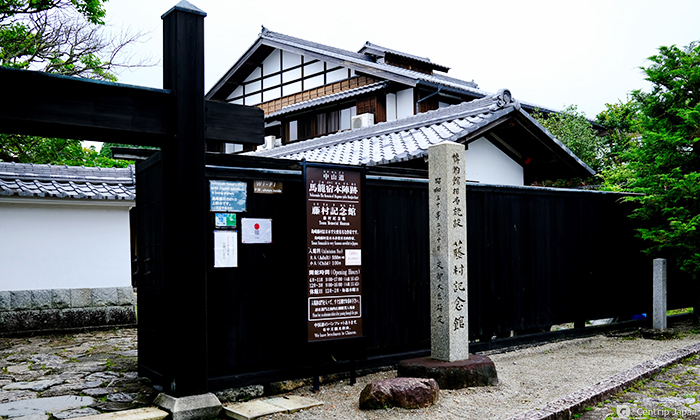 Toson Memorial Museum
Toson Memorial Museum
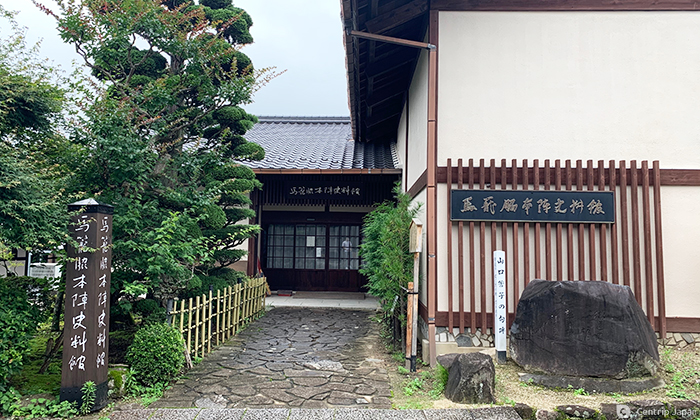 Magome Waki-Honjin Museum
Magome Waki-Honjin Museum
Magome-juku is the setting of Toson's novel. In the inn, you'll find the setting of "Before the Dawn" and the Toson Memorial Museum. In June 2020, the remains of Toson Shimazu's house at Toson Memorial Museum was recognized as a Japanese Heritage site by the Japanese Agency for Cultural Affairs.
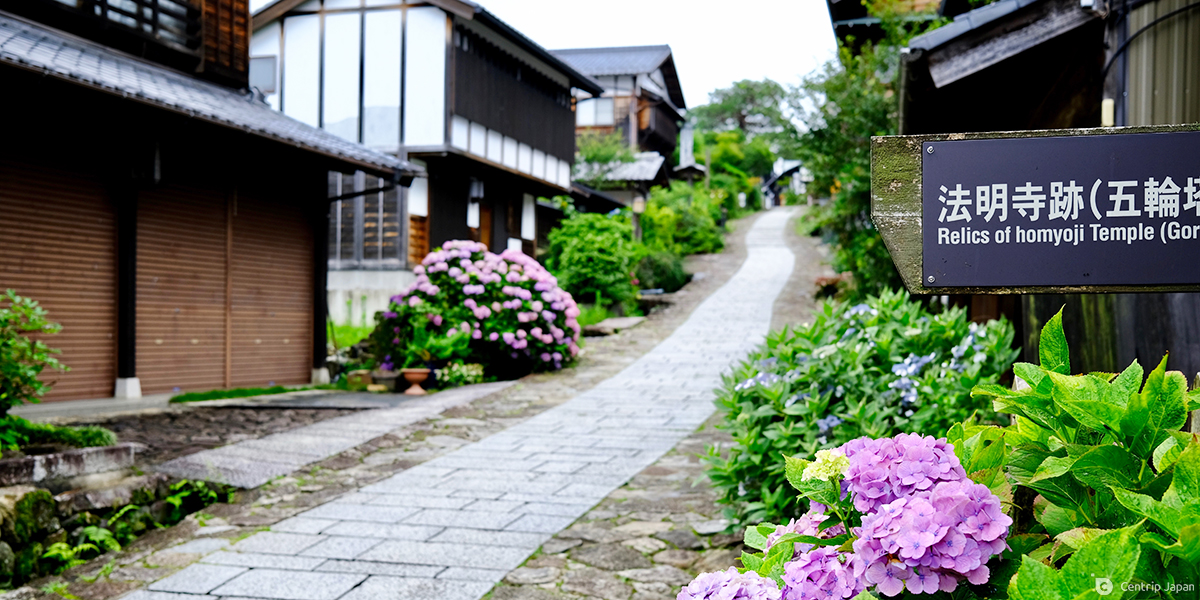
Magome-juku sits at an elevation of 600 meters above sea level. Magome-juku is unique because it's built along a slope, while other post towns are built on flat land.
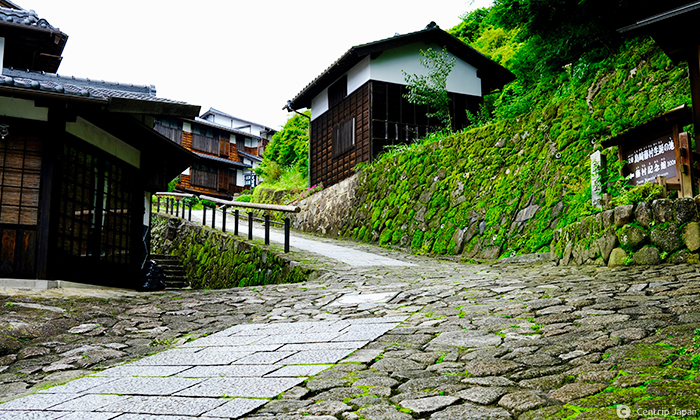 The steep slope continues.
The steep slope continues.
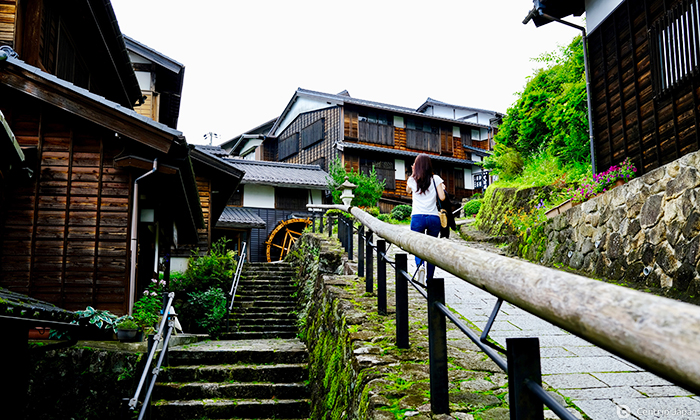 The water mill on the hill.
The water mill on the hill.
Historical buildings line both sides of the slope, and the views from the hillside are magnificent. On clear days the surrounding mountains are visible in the distance. Magome-juku continues for 600 meters, all uphill, but the views are remarkable and never get old.
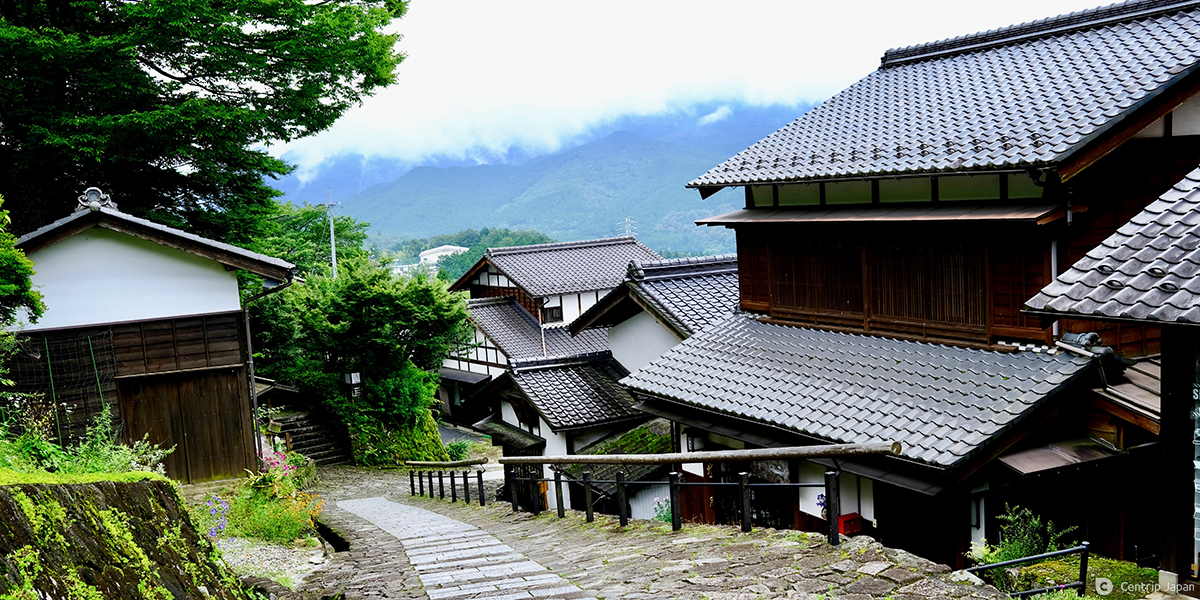
Along the way, many shops offer local delicacies such as Oyaki (Japanese dumplings) and Gohei-mochi (sweet rice cakes) for your consumption.
 Oyaki, one of the most popular local dishes.
Oyaki, one of the most popular local dishes.
 Magome-juku rain hats on display at souvenir shops
Magome-juku rain hats on display at souvenir shops
The walk from Magome-juku to Tsumago-juku is about 9 km or about 3 hours. Check out this article for more information on the hike.
Related articles
Castle in the Sky the Ruins of Naegi Castle
In addition to touring the post towns, if you're interested in Japanese history, you should visit the ruins of Naegi Castle. From Nakatsugawa Station, take the Kita Ena Koutsu bus bound for Tsukechikyo Kuraya Onsen or Kashimo Sogo Jimusho, and you'll arrive in about 12 minutes. From the bus stop, it will take approximately 30 minutes to reach the ruins of the Naegi Castle tower on foot.
Naegi Castle is built on top of a mountain by the Kiso River, taking advantage of the natural terrain. Huge rocks used in construction made the stone walls that protect the castle.
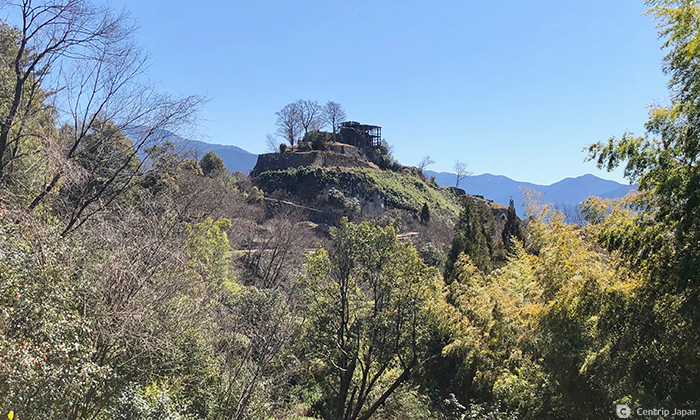 Remains of the castle remain at the top of the mountain.
Remains of the castle remain at the top of the mountain.
 Remains of a massive stone wall.
Remains of a massive stone wall.
From the top of the mountain, you can enjoy a spectacular view. Mt. Ena, the symbol of Nakatsugawa, can be seen beyond the flowing Kiso River.
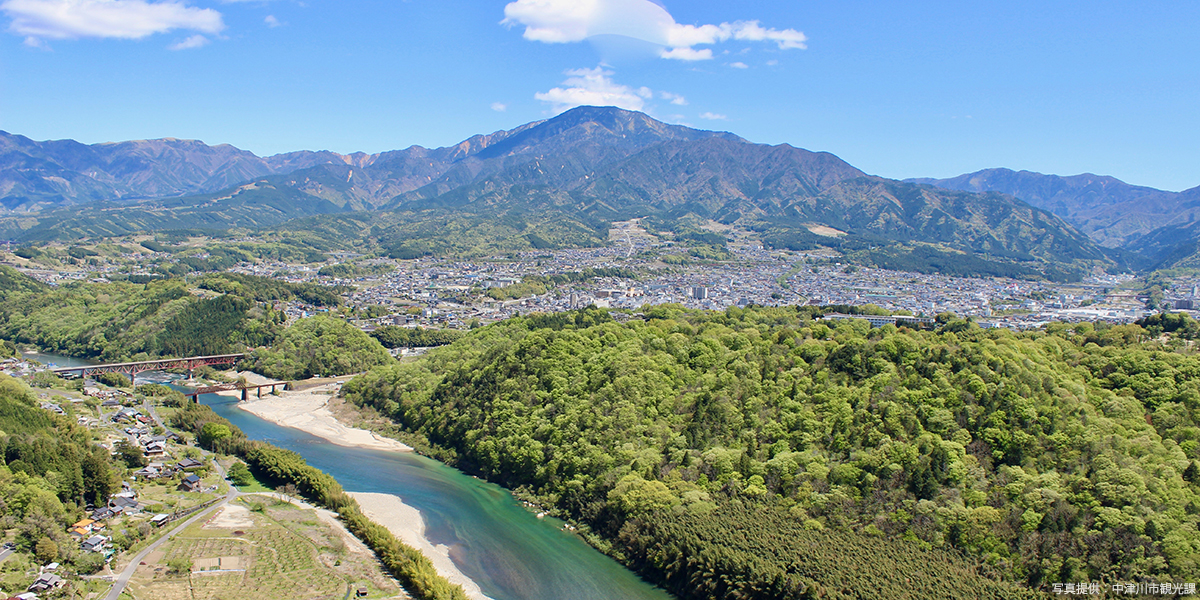
Chestnut-shaped sweet potatoes originating in Nakatsugawa
Nakatsugawa City is also known as the birthplace of Kuri-Kinton, a Japanese sweet made from chestnuts. There are many Kuri-Kinton shops in the city, including Suya, Kawakami-ya, and Shogetsu-do.
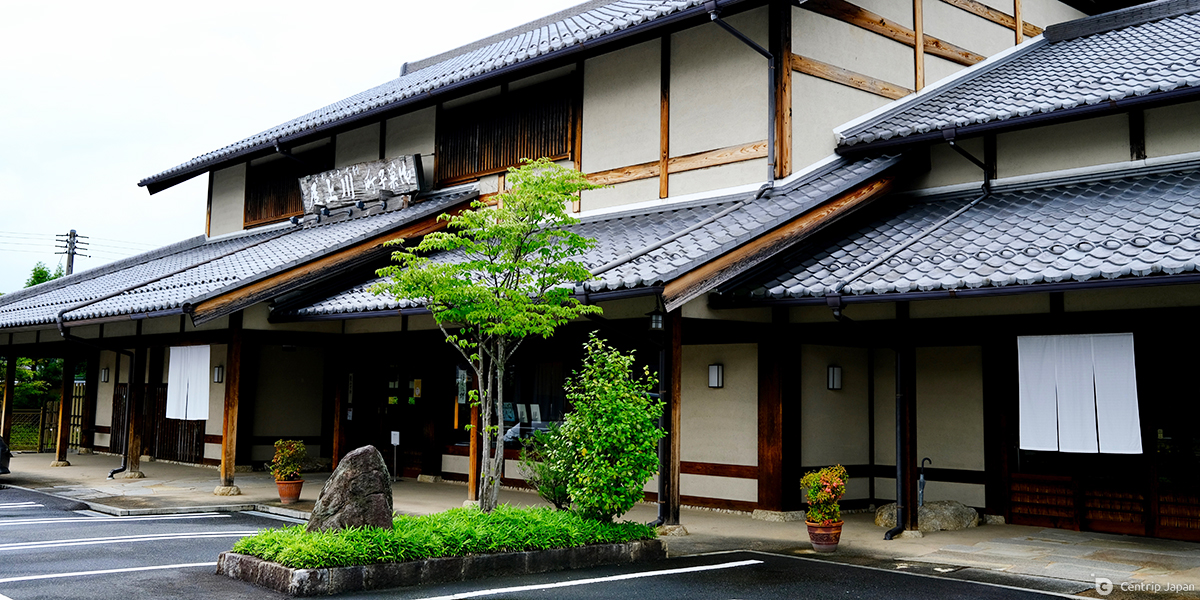
The tastes of each shop change by small degrees, so you can visit several shops to find the Kuri-Kinton that you like best. You can only eat Kuri-Kinton between September and January, but other chestnut sweets are on sale throughout the year.
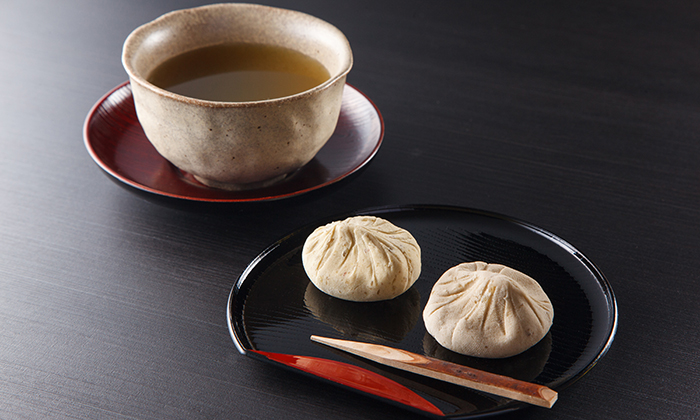 Nakatsugawa's famous chestnut Kuri-Kinton.
Nakatsugawa's famous chestnut Kuri-Kinton.
 Kawakamiya Chestnut Ice Cream
Kawakamiya Chestnut Ice Cream
Wrap-up
Post towns are places that let travelers feel as they've gone back in time to the Edo period. The charm of the old historical roads with their stone-paved streets, and the fantastic atmosphere of the ruins of Naegi Castle, will appeal to those who want to experience Japanese history and culture. Please traverse the Nakasendo Highway and relax while imagining history.
Click here to get the latest information on Central Japan.Centrip Japan - Nagoya and Chubu Information

